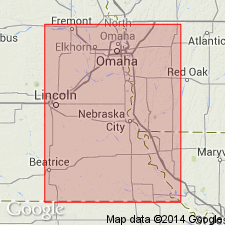
- Usage in publication:
-
- Coal Creek limestone bed
- Modifications:
-
- Original reference
- Dominant lithology:
-
- Limestone
- AAPG geologic province:
-
- Forest City basin
Summary:
Pg. 42, 52, 53. Coal Creek limestone bed of Topeka limestone member of Shawnee formation. The upper unit of Topeka limestone was named Union limestone by Condra and Bengston in 1915 (Nebraska Acad. Sci. Pubs., v. 9, no. 2). That name being preoccuppied the division is here named Coal Creek limestone, from exposures on Coal Creek, north of Union, [Cass County], southeastern Nebraska. The limestone is dark blue, dense, brittle, and quite fossiliferous. At Places it is split into 2 or 3 beds. Thickness 5+ feet in southeastern Nebraska and northwestern Missouri, 4+ feet in southwestern Iowa, and 3+ feet northeastern Kansas. Overlies Holt shale. Age is Late Pennsylvanian (Missouri age). Report includes cross sections, measured sections, geologic maps, stratigraphic tables.
Source: US geologic names lexicon (USGS Bull. 896, p. 472); GNC KS-NE Pennsylvanian Corr. Chart, sheet 1, Oct. 1936; supplemental information from GNU records (USGS DDS-6; Denver GNULEX).
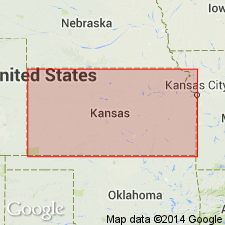
- Usage in publication:
-
- Coal Creek limestone member*
- Modifications:
-
- Overview
Summary:
Pg. 126 (fig. 22), 164-165. Coal Creek limestone member of Topeka formation; overlies Holt shale member; underlies Severy shale of Wabaunsee group. This classification agreed upon by State Geological Surveys of Iowa, Kansas, Missouri, Nebraska, and Oklahoma, May 1947. In Kansas, consists of light-bluish-gray limestone and nodular shale or dark-blue massive limestone which weathers light bluish gray or brown. Thickness 2 to 5 feet. Not positively identified south of Kansas River. Age is Late Pennsylvanian (Virgilian).
Source: US geologic names lexicon (USGS Bull. 1200, p. 854).
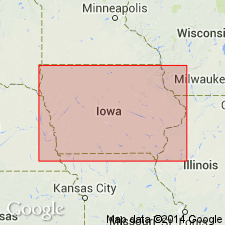
- Usage in publication:
-
- Coal Creek limestone member
- Modifications:
-
- Areal extent
Summary:
Pg. 15, fig. 5. Coal Creek limestone member of Topeka limestone. Medium- to dark-gray dense limestones interbedded with fossiliferous shales; locally contains dark chert. Thickness 5 to 6 feet. Upper unit of Topeka; overlies Holt shale member. Age is Late Pennsylvanian (Virgilian).
Source: US geologic names lexicon (USGS Bull. 1200, p. 854).
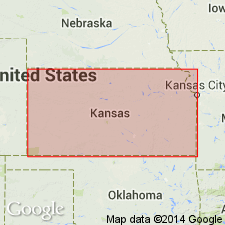
- Usage in publication:
-
- Coal Creek Limestone Member*
- Modifications:
-
- Overview
Summary:
(Paleozoic Era; Pennsylvanian System by J.M Jewett, H.G. O'Connor, and D.E. Zeller, p. 38.) Coal Creek Limestone Member of Topeka Limestone of Shawnee Group. Recognized in northeastern Kansas, but it is only locally identified in southeastern Kansas. Consists of light bluish-gray limestone and nodular shale or dark-blue, more massive limestone that weathers light bluish-gray or brown. Fusulinids are abundant, and at many places numerous other well-preserved invertebrate fossils are found. Thickness from 2 to 8.5 feet. Occurs above Holt Shale Member of Topeka Limestone and below Severy Shale of Sacfox subgroup [informal] of Wabaunsee Group. Age is Late Pennsylvanian (Virgilian).
["Subgroup" not recognized as a formal stratigraphic rank term (CSN, 1933; ACSN, 1961, 1970; NACSN, 1983, 2005, 2021). Considered informal and should not be capitalized.]
Source: Publication.
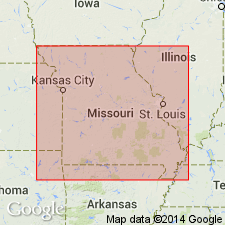
- Usage in publication:
-
- Coal Creek Limestone Member
- Modifications:
-
- Overview
Summary:
Pg. 123 (fig. 36), 126. Coal Creek Limestone Member of Topeka Formation of Shawnee Group. Recognized in northwestern Missouri. Argillaceous, brownish-weathering, wavy-bedded limestone beds separated by shale partings. Thickness from 4 to 5 feet. Occurs above Holt Shale Member of Topeka Formation and below Severy Formation of Wabaunsee Group. Fossiliferous (fusulinids). Age is Late Pennsylvanian (Virgilian).
Source: Publication.
For more information, please contact Nancy Stamm, Geologic Names Committee Secretary.
Asterisk (*) indicates published by U.S. Geological Survey authors.
"No current usage" (†) implies that a name has been abandoned or has fallen into disuse. Former usage and, if known, replacement name given in parentheses ( ).
Slash (/) indicates name conflicts with nomenclatural guidelines (CSN, 1933; ACSN, 1961, 1970; NACSN, 1983, 2005, 2021). May be explained within brackets ([ ]).

